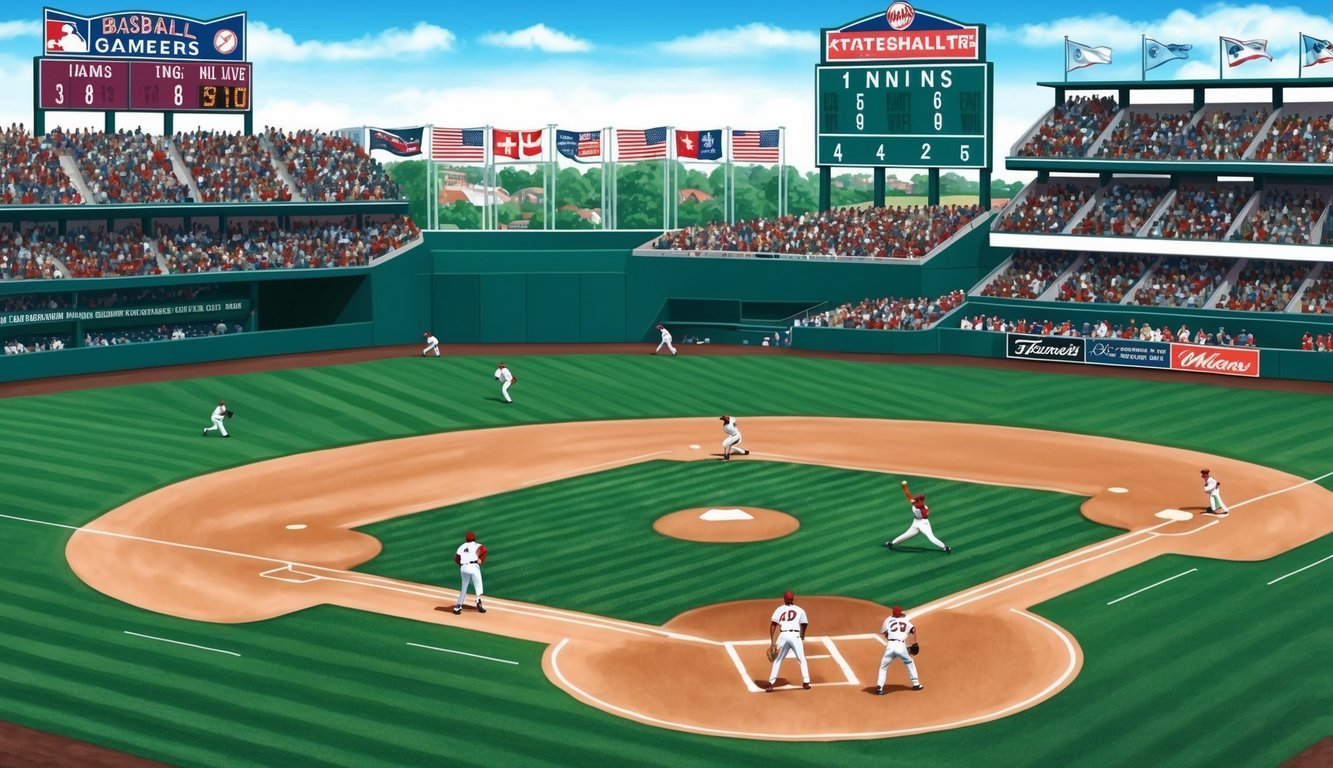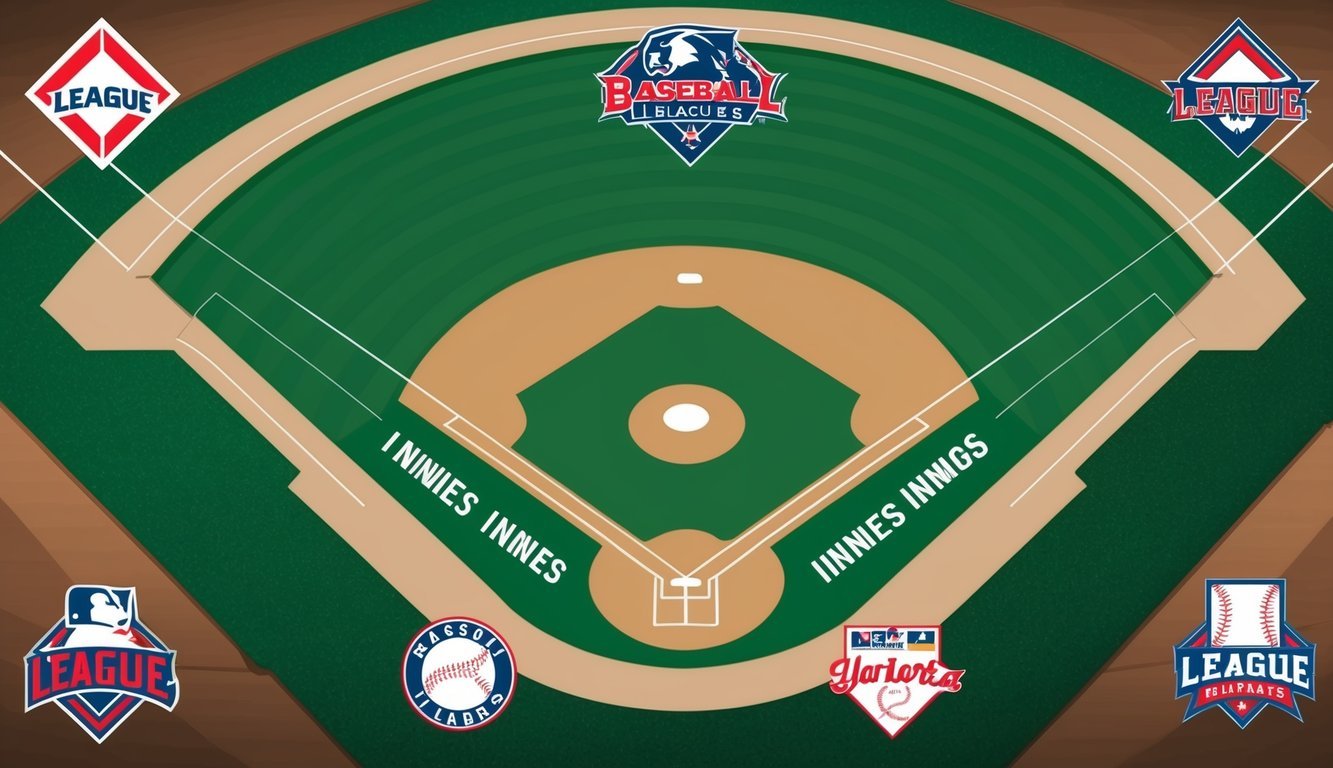Baseball, America’s favorite pastime, revolves around the concept of innings.
These structured segments form the backbone of the game, dictating its flow and strategy. A standard professional baseball game in Major League Baseball (MLB) consists of nine innings.
Each inning provides teams with opportunities to score runs and showcase their skills on both offense and defense.
The back-and-forth nature of innings creates suspense and excitement for fans, as momentum can shift at any moment.
If the score remains tied after nine innings, the game continues into extra innings until a winner emerges.
While nine innings is the norm for professional baseball, other levels of play may vary.
Youth leagues often play fewer innings to accommodate younger players’ stamina and time constraints.
Regardless of the number, innings remain the fundamental unit of play in baseball, shaping the sport’s unique rhythm and appeal.
Understanding Innings in Baseball
Innings form the core structure of a baseball game, dictating its flow and length.
They provide a balanced framework for both teams to showcase their offensive and defensive skills.
Basics of Innings
A standard baseball game consists of nine innings.
Each inning is split into two halves – the top and the bottom.
In the top half, the visiting team bats while the home team fields.
The roles reverse for the bottom half.
An inning ends when the fielding team records three outs.
Outs can occur through strikeouts, catches, or force plays.
If the score is tied after nine innings, the game continues into extra innings until a winner emerges.
Youth leagues often play shorter games, typically lasting six or seven innings due to time constraints and player stamina.
The Role of Time in Baseball
Unlike many sports, baseball isn’t governed by a clock.
This timeless aspect allows for dramatic comebacks and extended battles.
However, the pace of play remains a focus for leagues aiming to keep games engaging.
While innings determine a game’s structure, factors like pitching changes, mound visits, and batting performance influence its duration.
A typical MLB game lasts around three hours, though this can vary widely.
Some leagues have introduced pitch clocks to speed up play.
These timers limit how long pitchers can hold the ball between throws, adding a subtle time element to the innings-based format.
Structure of the Game
Baseball’s structure revolves around innings, with each team taking turns batting and fielding.
This format creates a rhythm and strategic flow unique to the sport.
One of the critical elements of a player’s performance is their batting average, which serves as a fundamental statistic for measuring success at the plate.
The batting average calculation explained involves taking the number of hits and dividing it by the total number of at-bats, providing a clear picture of a player’s ability to make contact with the ball and reach base safely.
This statistic not only reflects individual performance but also influences team dynamics and strategies throughout the game.
Starting Pitchers and Early Innings
Starting pitchers take center stage as the game begins.
They aim to establish dominance early, often relying on their best pitches to retire batters efficiently.
The home team’s pitcher faces the visiting team’s lineup first, setting the tone for the match.
Managers carefully monitor pitch counts and effectiveness.
Batters try to work deep counts, hoping to tire out the opposing pitcher.
Early innings often feature conservative play, with teams looking to score first and gain momentum.
Middle Innings Strategy
As the game progresses, strategy shifts.
Relief pitchers may enter if starters falter.
Managers consider pinch hitters and defensive substitutions to gain advantages.
Teams trailing may take more risks on the basepaths.
The fifth inning is crucial – it’s the earliest a game can become official if called due to weather.
Pitchers who last this long are in line for a potential win.
Batters adjust their approach after seeing a pitcher multiple times.
This cat-and-mouse game adds depth to the middle innings.
Ninth Inning Dynamics
The ninth inning brings heightened tension, especially in close games.
Home teams have the advantage of batting last if trailing.
This allows them to win dramatically with a walk-off hit or run.
Closers, specialized relief pitchers, often enter to secure the win for the leading team.
Managers may use pinch hitters aggressively, seeking clutch hits.
Base-running becomes more aggressive as teams down to their final outs.
If tied after nine, the game goes to extra innings.
This continues until one team leads after a full inning, adding unpredictability and excitement to the game’s conclusion.
Regulations and Exceptions

Baseball’s standard nine-inning format is subject to various rules and circumstances that can alter game length.
These regulations ensure fair play while adapting to different situations.
Extra Innings and Tiebreakers
When a game is tied after nine innings, play continues into extra innings.
Each team gets a chance to bat and score in each additional inning until one team leads at the end of a complete inning.
In 2020, MLB introduced a new rule for regular-season games: starting in the 10th inning, each team begins with a runner on second base to encourage scoring and shorten game times.
This rule change aimed to reduce the strain on pitching staffs during the shortened season.
Many fans have mixed feelings about this alteration to traditional gameplay.
In playoff games, teams play full extra innings without the runner on second base rule, maintaining the classic format for these high-stakes matchups.
The Mercy Rule Explained
The mercy rule, also known as the run rule, ends a game early when one team has an insurmountable lead.
This rule is common in youth leagues, high school, and college baseball, but it’s not used in professional MLB games.
Typically, the mercy rule takes effect if a team is ahead by:
- 10 runs after 5 innings (or 4.5 if the home team is winning)
- 15 runs after 4 innings
- 20 runs after 3 innings
The exact run differential and inning count can vary by league.
This rule helps prevent lopsided games from dragging on and protects young pitchers from overuse.
Impact of Weather and Doubleheaders
Weather conditions significantly influence baseball games. If rain or other inclement weather interrupts play, several outcomes are possible:
- Delay: Play resumes after the weather clears
- Postponement: The game is rescheduled, often as part of a doubleheader
- Called game: If at least 5 innings are complete, the game may be called official
Doubleheaders, where teams play two games in one day, often feature shortened 7-inning games to reduce player fatigue.
This format became more common during the COVID-19 pandemic to make up for postponed games.
In cases of extreme heat or cold, umpires and league officials may decide to shorten games for player safety.
These weather-related adjustments ensure the game can be played while prioritizing the well-being of all involved.
Variations Across Baseball Leagues

The number of innings played in baseball varies significantly across different leagues and levels of play.
These variations reflect the unique needs and traditions of each league.
Major League Baseball Vs. NCAA
MLB games typically last 9 innings, while NCAA games can vary.
Professional baseball maintains the 9-inning standard for regular-season games and most postseason matchups.
The World Series follows this format as well.
NCAA baseball generally aligns with MLB, playing 9-inning games.
However, some college baseball tournaments and doubleheaders may feature 7-inning games to manage player fatigue and time constraints.
In both leagues, extra innings come into play if the score is tied after the standard innings.
MLB has implemented a runner-on-second rule for extra innings to speed up game resolution.
International Differences in Baseball
Baseball innings can differ internationally.
Japanese professional baseball, like MLB, plays 9-inning games.
However, high school baseball in Japan often uses a 7-inning format.
Some international tournaments may adjust innings based on competition level or time constraints.
The World Baseball Classic, for example, uses the 9-inning format but has specific mercy rules.
European leagues sometimes adopt shorter game lengths to accommodate time limitations and player availability.
These variations highlight baseball’s adaptability across cultures.
Youth and Amateur Baseball Innings
Youth and amateur leagues often modify innings to suit younger players’ stamina and skill levels.
Little League games typically last 6 innings, balancing playing time with energy levels.
- T-ball: Usually 3-5 innings
- Minor League: Often 6 innings
- Major League (11-12 years): 6 innings
- Intermediate (11-13 years): 7 innings
Amateur adult leagues may play 7 or 9 innings, depending on local preferences and time constraints.
These adjustments ensure enjoyable and appropriate gameplay for all participants.
Final Inning Strategies
As the game nears its end, managers employ specific tactics to secure a win or mount a comeback.
Defensive shifts become more aggressive to prevent runs.
Pinch hitters and runners are frequently used to maximize offensive potential.
Closers, the team’s best relief pitchers, often enter to protect leads.
Speed on the basepaths becomes crucial.
Teams may attempt risky steals or sacrifice bunts to advance runners.
Intentional walks might be issued to set up double plays or face weaker batters.
Every pitch and at-bat carries heightened importance in these final moments.
